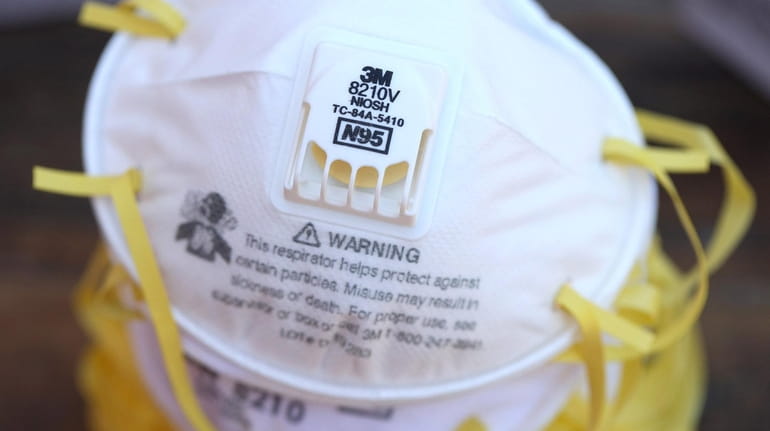Questions and answers about N95 and KN95 masks

A stack of 3M brand N95 particulate respirators. Credit: TNS/Justin Sullivan
The federal government is set to give away 400 million nonsurgical N95 masks through pharmacies and community health centers around the nation, possibly as early as next week.
Health experts have said both N95 and KN95 masks are more effective at protecting against COVID-19, but they can be expensive and hard to find.
Dr. Debbie Salas-Lopez, Northwell Health’s senior vice president for community and population health and chair of the Long Island Regional Health Equity Task Force, said it’s "incredibly important" to get N95 masks to underserved communities.
"They often don’t have access to masks in general and these masks are more protective, especially against [the omicron] variant," she said."These were the very communities that were devastated by COVID. They were more often infected, hospitalized or died. And so to get these resources out into these communities, or economically disadvantaged in general is really important."
She said sometimes people don’t know where to get the masks, can’t afford them or don’t even have information about the importance of wearing N95 masks.
"So it’s also about outreach and education and communication," she said.
Here is what you need to know about N95 and KN95 respirators/masks.
What are N95 masks?
What are N95 masks?
The N95 mask, also referred to as a respirator by the National Institute for Occupational Safety & Health, filters at least 95% of airborne particles when worn properly. Experts have said COVID-19, the disease caused by the SARS-CoV-2 virus, is transmitted through inhalation of respiratory droplets and aerosol particles.
The cup-like shape of the respirator/mask is designed to form a seal around a person’s nose and mouth. The U.S. Food and Drug Administration has said children and people with facial hair should not use N95s because they cannot be properly fit and they may not receive full protection.
Why are they better than surgical or cloth masks?
Why are they better than surgical or cloth masks?
According to the FDA, surgical masks can help block large particle droplets, splashes, sprays and splatter that might contain viruses and bacteria. But they do not filter or block small particles in the air transmitted by coughs and sneezes.
Surgical masks do not fit tightly across the face, so there are often gaps on the sides. Cloth masks also do not provide the same time of protection from airborne particles.
But officials from the Centers for Disease Control and Prevention and other health experts have said wearing any mask is better than wearing no mask at all. On its website, the CDC says people can wear a surgical mask under a cloth mask as a form of protection.
What are KN95 respirators/masks?
What are KN95 respirators/masks?
KN95 respirator masks are the most widely available respirators that meet an international standard, according to the CDC.
They also seal tightly to a person’s face when fitted properly and often appear to have a shape similar to a duck's bill.
The CDC says they filter "varying levels of particles in the air depending on the standard they are designed to meet."
But the agency also warns that about 60% of the KN95 respirators evaluated by NIOSH during 2020 and 2021 "did not meet requirements that they were intended to meet."
How do you know if you have a real N95 or KN95 mask and not a counterfeit?
How do you know if you have a real N95 or KN95 mask and not a counterfeit?
There are markings on these respirators/masks that indicate they are authentic, the CDC advises.
N95 masks approved by NIOSH will have several exterior markings, including the agency’s logo or name in block letters. There will be a TC approval number and a filter designation that says N95.
If you see CDC or NIOSH markings on a KN95 mask, it is misleading, the agency said, since they do not "approve KN95s or any other respiratory protective device certified to international standards."
For more information about respirators and masks, go to cdc.gov.

